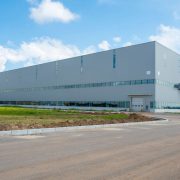Checking in with the Experts: CRE Deal-making Slows as Debt Becomes More Scarce
For investors looking to deploy capital or an owner-occupier trying to combat industrial rent inflation by purchasing their own building, the Halloween headlines from the Wall Street Journal and Bisnow were frightening. The Money Has Stopped Flowing in Commercial Real Estate warned the WSJ, and Bisnow’s headline blared, Scarcity Of Capital Hammers CRE.
The Journal reported that CMBS originations were down to $28.2 billion for the year — the lowest figure since 2011 — and Bisnow added that commercial property sales were down 53% year-over-year in Q3, according to MSCI Real Assets.
At the heart of the problem is the dramatic rate increases by the Fed that began in the Spring of 2022, and — despite two pauses in increases in September and November — there is no guarantee that the hoped-for decreases will materialize in 2024. Further compounding the problem is the elevated valuations of assets, as the Fed wrote in its October 2023 Financial Stability Report, “Valuation pressures arise when asset prices are high relative to economic fundamentals or historical norms (now prevalent in commercial real estate, particularly office) and “elevated valuation pressures can increase the possibility of outsized drops in asset prices.”
To get a better perspective on the debt market, we turned to our experts.
Rob Quarton, Senior Director, Capital Markets for Walker & Dunlop
The rapid rise in interest rates — whether fixed or floating rates — has made returns to investors a little more challenged, says Quarton. “Cap rates haven’t adjusted on par to how much interest rates have moved, and the U.S. treasuries have essentially doubled over the last 18 months,” he reports. “Debt leverage is down and interest rates are up, which is making it challenging to achieve accretive returns from real estate. There is a lot of capital available or dry powder, but the majority of opportunities in the market are having a tough time matching the yield requirements of lenders and equity investors today.”
Institutional investors and funds typically have a portfolio allocation to commercial real estate, but in light of market conditions, some of that money is being diverted to other investment vehicles with better relative returns like U.S. Treasuries, which briefly topped 5% in October 2023. “The treasury bonds are looking pretty attractive right now, so if an investor can buy a treasury bond for 4.5% to 5%, they’re definitely going to want a risk premium to the treasury yield to buy commercial real estate,” says Quarton. “And that’s the macro theme that’s currently playing out and causing a pause in transaction volumes.”
Loan Origination
Despite the issues in the capital markets, Quarton says that his team is still very active. “We’re as busy as ever because borrowers need a little bit more help right now. Maybe their existing lenders are not providing them the same level of financing or none at all, or the structure is not advantageous. So, we’re getting calls from people looking to expand their relationships and find new lenders.” CMBS, Life Insurance Companies and other private lenders have been filling the void left by the contraction in the banking sector.

Quarton expressed concern about the volume of loans that are set to mature in the near future. “In our opinion, there’s a pretty substantial loan maturity wave that’s already started, and it’s really going to hit the crest next year and into 2025,” he says. As the commercial real estate market emerged from COVID in late 2020, there was a flood of capital in the market that was deployed into commercial real estate. Many of those were three-year loans that are now beginning to mature. The bulk of those loans were made in 2021 and will reset in 2024. “That maturity wave is going to be a pivotal force in the market that is going to increase velocity and momentum,” said Quarton. “That’s what we’re starting to see, and as we get into next year, that could allow more lenders and investors to deploy capital along with investor to make acquisitions.”
Mike Hefner, SIOR, Executive VP, Voit Real Estate Services, Anaheim

“Right now, we have very conservative loan-to-value ratios (50% or lower), and interest rates that are double what they were in early 2022, making borrowing a lot more expensive and very challenging to secure,” says Hefner, who adds that there’s been a significant change in cap rates and overall pricing since earlier in 2023.
Additionally, there has been a significant pullback from institutional buyers, he says, because even though many close on a cash basis, they often secure financing after the asset has been stabilized, “so the cost of debt is factored into their analysis.” As a result, private investors can now compete with the institutional capital that drove pricing for the last three years. One emerging buyers group is owner-occupiers, which had been sidelined until recently. “Users were out of the marketplace — not by choice but by being outbid by institutions over the last two or three years,” says Hefner. Additionally, institutional players who had typically targeted larger buildings were dropping down to buildings as small as 25,000 square feet.
“If you were a user competing for a building you want to occupy for your own business, you were competing with an all-cash institutional buyer that could perform (close) in 30 days,” says Hefner. “Many investors are now on the side lines and the few that are still active are much more selective which is creating an opportunity for owner-users.” At least in theory. There is still a shortage of for-sale industrial properties in the Southern California market as owners hold out for top pricing.
“Just because an owner takes a property to market doesn’t mean he’s ready to trade,” says Hefner. “If you can’t achieve target pricing and don’t need to sell, why sell if it’s a performing asset?”
Randall LaChance, Executive VP, Voit Real Estate Services, San Diego
LaChance says the shifts in the debt market have had a relatively small effect on the owner-user market, except as it relates to time on the market. “We used to put a building on the market at something above the most recent sale price, and you could expect to get multiple offers and a choice of buyers,” he says. “The valuations were always above previous sales, and you could price it high enough so that you didn’t leave any money on the table. Today they’re still selling at or slightly above the previous sales for similar property, but it’s taking longer to find the buyer.”
While owners could previously expect to have two or three offers the first two weeks after the property was put on the market, it may now take three to four months to find a buyer, although pricing is still at or above the last sale. “This is happening across our industrial market, and I think it’s because these (potential) owner-occupants who are currently tenants are tired of the 25%-50% rent increases when their lease renews.” (According to Voit market research, renewing at today’s rates will inflate the rental expense for companies by 50% to 75% across most SoCal markets). “And while you can’t own a building cheaper than you can rent it, when you start looking at the tax savings and the fixed rate financing (it makes sense).”
Investment Sales Slow to Crawl

On the investment sales front, “somebody just turned the spigot off,” says LaChance. He tracks investment sales of $5 million or greater in San Diego County and has seen a significant drop-off in sales volume. While the market typically sees an average of 40 transactions per quarter across all asset classes, Q3 saw only 18 — the lowest quarter since COVID hit in Q2 of 2020. Many of those deals were 1031 exchanges or office properties being converted to residential, and he attributes the sales volume decrease to institutional players remaining on the sidelines.
Looking ahead, LaChance has concerns over the uncertainty in the market — specifically, where the debt market is going to be in the future. “Literally just six months ago, everybody felt that the Fed was going to start lowering rates starting in 2024,” says LaChance.
Uncertainty in markets and underwriting has always caused a pause in transaction volume. Once the Fed has officially stopped raising rates or announces that they may reduce rates we will see a return to market activity, albeit most likely at “new” price levels.
For further insights, contact Mike Hefner or Randy LaChance at Voit Real Estate Services or Rob Quarton at Walker & Dunlop.









